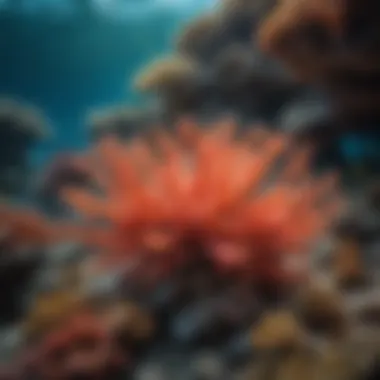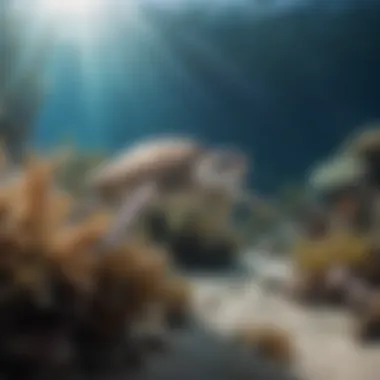The Great Barrier Reef: Ecology and Challenges


Intro
The Great Barrier Reef, located off the coast of Queensland, Australia, represents one of the most spectacular marine ecosystems on the planet. As the world's largest coral reef system, it covers an area of roughly 344,400 square kilometers. This vibrant underwater landscape is home to a diverse array of marine life, ranging from colorful coral species to numerous fish varieties, mollusks, and marine mammals. However, this rich biodiversity faces significant threats from climate change, pollution, and human activities, highlighting the urgent need for conservation efforts.
Understanding the complexities of the Great Barrier Reef is essential not only for marine biologists, but also for anyone interested in environmental science and conservation. The challenges this ecosystem encounters offer a window into broader issues affecting marine environments globally. From rising sea temperatures to ocean acidification, the variations in climate profoundly impact coral health and resilience.
This article aims to unravel the intricate relationship between the reef's ecological significance and the threats it faces, providing a clear framework for understanding the interplay of human impact and natural processes. By examining ongoing research and conservation initiatives, readers will gain insights into how we can collectively contribute to the reef's preservation.
Preamble to the Great Barrier Reef
The Great Barrier Reef stands as a remarkable testament to nature's artistry and biological diversity. This extensive coral reef system, which is the largest in the world, is located off the coast of Queensland, Australia. It is not just an ecological wonder but also a vital component of the marine environment, supporting countless species and contributing tremendously to global biodiversity.
Understanding the Great Barrier Reef encapsulates both its splendor and the pressing challenges it faces. This delicate ecosystem sustains a rich tapestry of marine life, from vibrant corals to diverse fish species. The reef is designated as a UNESCO World Heritage site, emphasizing its global significance.
As coastal erosion escalates and climate change continues to take its toll, recognizing the importance of studying this ecosystem is vital. The consequences of neglecting the reef affect not only marine wildlife but also the human populations that depend on its resources for livelihoods, tourism, and coastal protection. In this context, learning about the reef’s structure, functioning, and its interdependencies offers necessary insights into conservation strategies that can be employed.
Geographical Location
The Great Barrier Reef stretches over 2,300 kilometers (1,400 miles) along the northeastern coast of Australia. It encompasses approximately 344,400 square kilometers, making it a natural wonder visible from outer space. The reef is situated in the Coral Sea and extends from the northern tip of Queensland down to just north of Brisbane.
The geographical layout of the Great Barrier Reef consists of around 900 islands and 3,000 individual reefs. Notably, it is home to several distinct ecosystems, including estuaries, mangroves, and coral cays.
Historical Context
The Great Barrier Reef has a long history, both ecologically and culturally. Indigenous Australian peoples have inhabited the coastal areas surrounding the reef for thousands of years, relying on its resources for sustenance, trade, and cultural practices. Their deep connection to the reef is still evident today, with knowledge passed down through generations contributing to contemporary conservation efforts.
In the late 18th century, European exploration marked an intensified interest in the reef. Subsequent to this, there were numerous expeditions aimed at understanding its ecology and resources.
The rise of tourism in the 20th century brought both opportunities and challenges. While tourism provided economic benefits, it also led to environmental pressures. Therefore, the historical interplay between human activity and ecological balance is a critical aspect when examining the current state of the reef.
Ultimately, an exploration of the Great Barrier Reef requires an understanding of its geographical and historical contexts to appreciate the broader implications of its ecological conditions.
Ecological Importance of the Reef
The Great Barrier Reef stands as one of the most valuable ecosystems on the planet. Its ecological importance extends beyond mere aesthetic value; it is a complex network that supports a vast array of marine life, influences coastal health, and underpins local economies. Understanding this importance is crucial for anyone concerned with marine conservation, sustainability, and biodiversity. The reef's ability to provide essential ecosystem services makes it a focal point for environmental stewardship and scientific research.
Biodiversity Hotspot
Species Diversity
Species diversity in the Great Barrier Reef is remarkable. It hosts approximately 1,500 species of fish, 400 species of coral, and numerous other marine organisms. This extensive variety plays a critical role in maintaining the overall health of the ecosystem. Each species contributes uniquely to the reef's functions, forming intricate food webs that sustain various life forms. A key characteristic of this diversity is its resilience; the presence of numerous species increases the system's adaptability to disturbances. The unique feature of high species diversity is that it often enhances ecosystem stability. In this article, we highlight how vital species diversity is for ecological balance and resilience against changing environmental conditions.
Endemism
Endemism refers to species that are unique to a particular geographic location. In the Great Barrier Reef, some fish and coral species are endemic, which makes the reef even more significant. This unique biodiversity contributes to scientific interest and is a critical aspect of the overall conservation narrative. These endemic species often exhibit special adaptations that allow them to thrive in their specific environments. The unique feature of endemism is its contribution to the novelty of marine ecosystems; it fosters a sense of uniqueness and urgency in conservation efforts. Understanding endemism aids in protecting not just the species themselves, but also the flexible and shifting ecosystems they inhabit.
Ecosystem Services
Coastal Protection


The Great Barrier Reef provides essential coastal protection. It acts as a natural barrier against waves and storms, significantly reducing coastal erosion. The coral structures dissipate wave energy, helping to protect beaches and coastal settlements. A notable aspect of this service is its economic impact; healthy reefs equate to decreased costs for coastal infrastructure. This article explores how coastal protection offered by the reef is crucial for the stability of nearby human communities and natural habitats. A critical advantage is reducing risk from severe weather, contributing to overall community resilience.
Tourism and Economy
Tourism driven by the Great Barrier Reef is an important economic factor for Australia. This reef attracts millions of visitors each year, generating significant income for local businesses. Moreover, it promotes awareness of marine ecosystems and the necessity for conservation. The unique feature of this tourism is that it not only brings economic benefits but also serves as an educational platform, encouraging stewardship of the marine environment. However, the reliance on tourism also presents challenges, as unregulated activities can threaten the reef's health. Thus, finding a balance between economic benefit and environmental protection is essential in the overall discussion of sustainability.
Coral Biology
Coral biology is central to understanding the Great Barrier Reef and its ecological dynamics. This field encompasses the anatomy, physiology, and behavior of corals, which are keystone species in the reef ecosystem. The health of coral populations directly impacts the complex web of life within the reef system. As climate change and other challenges threaten the reefs, comprehending coral biology becomes even more relevant. By exploring coral structure, function, and symbiotic relationships, one can appreciate how these organisms sustain biodiversity and contribute to ecosystem services.
Coral Structure and Function
Coral structures are primarily made up of calcium carbonate, creating the hard skeleton that forms reefs. These structures provide habitats for numerous marine species, both fish and invertebrates. Corals can be categorized into two main types: hard corals and soft corals. Hard corals build reefs, while soft corals lend diversity and beauty to the ecosystem.
The function of corals is multifaceted. They not only provide shelter but also serve as a food source for various species. This dual role is critical for maintaining the ecological balance. Health of coral systems influences overall reef resilience, making this aspect key to conservation efforts.
Symbiotic Relationships
Symbiotic relationships are vital to coral health and productivity. Most corals engage in a mutualistic relationship with tiny algae called zooxanthellae. These algae reside within coral tissues and perform photosynthesis.
Zooxanthellae
The presence of zooxanthellae is a critical aspect of the coral's energy dynamics. They provide carbohydrates to corals through photosynthesis. In return, corals offer a protected environment and access to sunlight. This relationship is beneficial because it enhances coral growth and resilience.
One key characteristic of zooxanthellae is their ability to adapt to varying light levels. This adaptability means that they can thrive in different environments, benefiting the corals they inhabit. However, environmental changes can lead to the expulsion of these algae, causing coral bleaching and subsequent mortality.
Interactions with Marine Life
Interactions with marine life further enrich the coral ecosystem. Many fish species rely on coral reefs for shelter and food. The structural complexity of coral provides numerous niches for various organisms, fostering a diverse community.
A significant characteristic of these interactions is the role of herbivorous fish. Species like parrotfish consume algae that can otherwise overgrow coral. This behavior not only aids in maintaining coral health but also enhances reef resilience. However, overfishing and habitat degradation can disrupt these interactions, jeopardizing the balance of the reef ecosystem.
Coral systems are not just beautiful; they are vital for the planet's biodiversity and health, supporting marine life while also protecting coastlines from erosion.
Understanding coral biology facilitates effective conservation strategies that are essential for the survival of the Great Barrier Reef amidst ongoing environmental challenges.
Threats Facing the Great Barrier Reef
The Great Barrier Reef is under constant threat from multiple sources. These threats jeopardize its ecological balance and overall health. Understanding these threats is key to developing effective strategies for conservation and management. It is critical to recognize the interconnectedness of these challenges, as they often compound each other.
Climate Change
Rising Sea Temperatures
Rising sea temperatures are a direct consequence of climate change. These elevated temperatures have significant effects on coral ecosystems. Warmer water conditions can lead to coral bleaching, a stress response that weakens coral and makes them susceptible to disease. This phenomenon also has implications for marine biodiversity, as many species rely on coral habitats for survival. The importance of addressing rising sea temperatures cannot be overstated. Protecting the reef from this threat ensures the preservation of its ecological functions.
Ocean Acidification
Ocean acidification results from increased CO2 absorption by ocean waters. This chemical change affects the ability of marine organisms, particularly corals, to build their calcium carbonate structures. Lower pH levels compromise the structural integrity of corals, affecting their growth and survival. Understanding ocean acidification is crucial, as it poses long-term risks to coral ecosystems. The unique feature of this threat is its gradual progression, making it less visible but equally damaging. Mitigating carbon emissions can help to slow acidification, benefiting the reef's resilience.


Pollution and Runoff
Agricultural Chemicals
Agricultural chemicals, such as fertilizers and pesticides, pose serious risks to the Great Barrier Reef. When these substances enter the waterways, they can lead to nutrient pollution, resulting in algal blooms that outcompete corals for resources. This disrupts the natural balance and harms marine life. Addressing agricultural run-off is essential for maintaining the reef's water quality. A notable aspect of this issue is the impact on both aquatic and terrestrial ecosystems, further illustrating the need for holistic approaches.
Plastic Waste
Plastic waste has emerged as a significant threat to marine environments, including the Great Barrier Reef. This waste can cause physical harm to marine organisms, and smaller particles can enter the food web, potentially affecting human health. The distinctive feature of plastic pollution is its long-lasting nature, as plastics can take hundreds of years to decompose. Focusing on reducing plastic usage and improving waste management practices will greatly benefit the reef and marine life.
Overfishing and Unsustainable Practices
Overfishing presents a formidable challenge to the Great Barrier Reef. Unsustainable practices lead to the depletion of fish stocks and disrupt the natural food chain. The removal of key species can affect the entire ecosystem, impacting both the reef and the communities that depend on it for livelihoods. Sustainable fishing practices and stricter regulations are vital in mitigating these impacts. Ensuring fisheries can thrive alongside the reef is critical to preserving this unique environment.
Conservation Efforts
Conservation efforts are crucial in maintaining the health and sustainability of the Great Barrier Reef. As a delicate ecosystem, the reef faces numerous threats from human activity and climate change, necessitating proactive measures to protect its biodiversity and ecological functions. These efforts aim not only to conserve existing habitats but also to restore damaged areas, ensuring the survival of various species and the overall resilience of the reef. By understanding and supporting these initiatives, it is possible to mitigate some of the adverse effects of pollution and habitat destruction.
Marine Protected Areas
Marine Protected Areas (MPAs) are designated regions of the ocean where human activity is restricted to protect the environment and wildlife. The Great Barrier Reef employs a network of MPAs that serve multiple purposes. They provide safe habitats for marine life, promote biodiversity, and help ecosystems recover from anthropogenic stressors. The establishment of MPAs enables fish populations to replenish and preserves essential nursery habitats critical for various species.
In these areas, regulations on fishing and tourism activities are strictly enforced. This leads to healthier fish stocks and allows local ecosystems to thrive. Research indicates that MPAs can enhance resilience against climatic stress, making it a significant strategy in conservation efforts. However, continuous monitoring and evaluation are required to adapt to changing conditions and ensure their effectiveness over time.
Restoration Projects
Restoration projects are essential in repairing the damage caused by human impacts and climate change. They encompass various strategies, including coral planting and habitat rehabilitation, aimed at fostering recovery of the reef.
Coral Planting Initiatives
Coral planting initiatives are a proactive approach to restoring damaged or degraded coral reefs. These projects involve the cultivation of coral fragments in nurseries, which are then transplanted onto the reef. This method helps to accelerate reef recovery and promotes biodiversity. One key characteristic of coral planting is its ability to increase the structural complexity of the reef, providing habitats for marine species.
The effectiveness of coral planting initiatives also lies in their community involvement. They often engage local volunteers, raising awareness about the importance of coral ecosystems. However, it is worth noting that while coral planting can yield immediate benefits, long-term success hinges on addressing the underlying threats, such as pollution and climate change. Without addressing these concerns, the efforts may be short-lived.
Community Involvement
Community involvement plays a significant role in conservation and restoration efforts. Engaging local populations fosters a sense of stewardship and responsibility toward the reef. This collective effort enhances the efficacy of conservation projects as the community often possesses valuable local knowledge about the ecosystem.
A key characteristic of community involvement is its power to unite diverse groups toward a common goal. This collaboration creates a robust support system for various initiatives, from beach clean-ups to educational programs. Involving the community in conservation not only empowers individuals but also ensures long-term commitment to sustainable practices. However, the challenge remains in bridging the gap between local interests and broader conservation objectives. This balancing act is necessary to maintain ecosystem health and ensure the reef's future.
"To ensure the proper care of the Great Barrier Reef, both conservation efforts and community actions are necessary, combining scientific knowledge with local expertise."
Research and Monitoring
Research and monitoring are crucial for understanding the health and changes within the Great Barrier Reef ecosystem. These efforts help scientists, policymakers, and educators make informed decisions to protect and conserve this vital marine habitat. By systematically gathering data, researchers can assess the impacts of various threats and the effectiveness of conservation efforts.
Scientific Studies
Long-Term Ecological Research


Long-term ecological research on the Great Barrier Reef offers important insights into how this ecosystem functions and evolves over time. One key characteristic of this type of study is its duration. Many projects last for years or even decades. This extended timeframe allows scientists to observe trends and changes that shorter studies might miss. It benefits the overall objective of understanding ecological dynamics and provides a solid foundation for conservation strategies.
A unique feature of long-term studies is their ability to connect different environmental factors with coral health. For example, researchers can analyze how variations in sea temperature influence coral bleaching events over the years. However, these studies come with disadvantages. They require significant resources and commitment, making them less adaptable to sudden ecological changes.
Technological Innovations
Technological innovations play a pivotal role in modern research efforts concerning the Great Barrier Reef. These innovations encompass a range of advanced tools such as underwater drones, remote sensing technology, and data analytics. Their key characteristic is the ability to collect vast amounts of data quickly and with precision. This efficiency is beneficial for monitoring hard-to-reach areas of the reef and gathering information on various marine species.
One unique aspect of technological innovations is their capability for real-time data collection. This allows scientists to respond quickly to changes in environmental conditions, offering a timely response to potential threats. However, reliance on technology can have disadvantages. For example, these tools may require specialized training or be expensive, limiting access for some researchers.
Community Science
Community science, also known as citizen science, involves public participation in scientific research. This approach is significant for the Great Barrier Reef as it engages local communities, tourists, and enthusiasts in monitoring reef health. Participants can record observations, report changes in coral conditions, and contribute to a larger pool of data that enhances scientific studies.
Community science not only broadens the data collection scope but also fosters a greater sense of stewardship among participants. Those involved often develop a deeper understanding of the reef’s ecological importance. However, ensuring accurate data collection from volunteers presents challenges. Reliability and consistency are key factors that researchers must address in order to validate community contributions.
Cultural Significance of the Great Barrier Reef
The Great Barrier Reef holds immense cultural significance, both for Indigenous communities and modern society. Understanding this aspect is crucial because it intertwines ecological preservation with cultural values. The reef is not just a natural wonder; it is a living landscape that has shaped the identities, traditions, and livelihoods of the people who inhabit its regions.
Indigenous Perspectives
The Indigenous peoples of Australia, particularly those tribes from the coastal regions surrounding the Great Barrier Reef, have a profound connection to their environment. For these communities, the reef is a source of sustenance and a vital part of their cultural heritage. They view the waters and reefs not merely as resources but as ancestors and spirits that have guided and nurtured their existence for thousands of years.
Traditional ecological knowledge (TEK) plays a significant role in how these communities interact with the reef. They possess a deep understanding of the ecological systems, recognizing the importance of every species and habitat. This knowledge informs their sustainable fishing practices and conservation methods, which contrast starkly with modern exploitative practices.
"The Reef is not just a place; it is part of our family history, our spirituality, and our future."
— Indigenous Elder
Tourism and Education
The Great Barrier Reef also serves as a focal point for education and tourism. Each year, millions of visitors flock to the reef, drawn by its breathtaking beauty and unique ecosystems. Educational programs are integral to the tourism strategy, aiming to raise awareness about marine conservation among visitors. This awareness is critical, especially in light of the challenges the reef faces.
Tourism generates significant economic benefits, providing jobs and funding for conservation efforts. However, it also requires careful management to prevent environmental degradation. Sustainable tourism practices aim to respect the delicate balance between visitor enjoyment and ecological integrity. Educational tours, marine biology workshops, and community involvement initiatives facilitate a greater understanding of the reef's significance.
The dual role of the reef as a place of cultural importance and a tourism hotspot highlights the need for a balanced approach to its management. By uniting Indigenous knowledge with modern conservation efforts, stakeholders can work towards a more sustainable future for the Great Barrier Reef, ensuring it retains its biological and cultural richness for generations to come.
End and Future Outlook
The Great Barrier Reef stands as a monumental site of ecological wonder and a vital resource for biodiversity and humanity. However, its future remains precarious due to various threats. To consider the outlook for this natural marvel, one must evaluate the importance of sustainable practices and community involvement in conservation efforts. Together, these elements could shape the destiny of the reef and provide a pathway to its recovery.
Sustainable Practices
Sustainable practices are crucial for the protection and preservation of the Great Barrier Reef. They encompass a range of strategies aimed at minimizing human impact on this delicate ecosystem. These include responsible tourism, sustainable fishing and agriculture, and stricter regulations on waste management. By adopting eco-friendly practices, stakeholders can lessen the negative influences on the reef.
- Responsible Tourism: Promoting tours that educate visitors about the reef while ensuring minimal environmental impact. This includes limiting the number of tourist vessels in sensitive areas and providing guidelines for behavior around marine life.
- Sustainable Fishing: Implementing fishing regulations that protect juvenile fish populations can help ensure the overall health of the reef's ecosystem. Supporting local fisheries that adhere to sustainable practices can also minimize overfishing.
- Pollution Control: Strategies such as using fewer chemicals in agriculture and reducing plastic waste are necessary. Ensuring proper waste disposal and investing in pollution filtration systems can directly benefit the water quality near the reef.
The integration of these practices not only protects marine life but also preserves the reef for future generations. An engaged community is the backbone of these efforts.
Call to Action
To safeguard the Great Barrier Reef, a collective call to action is essential. Individuals, communities, and governments must initiate and support that initiatives can lead to meaningful change.
- Awareness Campaigns: Raise awareness about the reef and its importance through educational programs in schools and community centers. More informed citizens can lead to more substantial support for conservation initiatives.
- Volunteer Programs: Engage local communities in volunteering with organizations dedicated to reef conservation. Involvement in activities such as coral planting or beach clean-ups fosters a sense of responsibility toward environmental stewardship.
- Policy Advocacy: Advocate for stronger environmental regulations and policies that defend the reef. Contacting local representatives and participating in initiatives can amplify the voice for change.
"The health of the Great Barrier Reef reflects the health of our planet. Protecting it is not just a local responsibility, but a global one."







